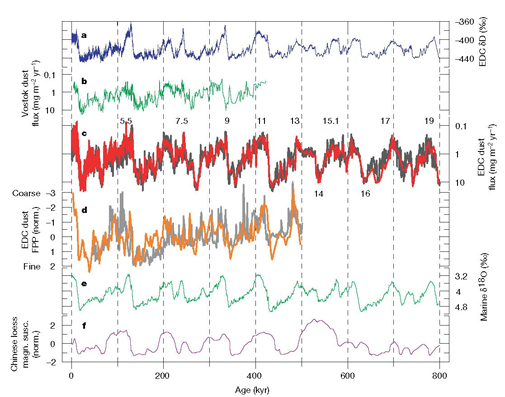Another core bites the dust

A high-resolution dust record from an ice core in East Antarctica sheds new light on the interplay between dust flux and climate. The ice core, which provides an undisturbed climate sequence for the past 800,000 years, shows that dust flux is strongly correlated with Antarctic temperature during glacial periods.
Dust particles in the atmosphere can affect temperature by absorbing or reflecting incoming solar radiation. Moreover, previous studies have suggested that production, transport and deposition of dust can be influenced by climatic changes on glacial-interglacial timescales.
In Nature on the 3 April 2008 on pp 616-619, Fabrice Lambert and colleagues present a high-resolution record of dust from the EPICA (European Project for Ice Coring in Antarctica) Dome C ice core in East Antarctica. They then match this record to climate indicators such as stable isotopes from ice cores and marine sediments. The record confirms increased atmospheric dust loading during cold episodes in the Quaternary period. The data suggest that dust is linked to temperature as the climate becomes colder, pointing to a gradual influence of the glacial Antarctic climate on lower-latitude climate.
The authors propose that the observed increase in glacial dust flux over the last eight glacial periods can be attributed to a strengthening of South American dust sources, together with a longer atmospheric dust particle lifetime in the upper troposphere resulting from a reduced hydrological cycle during the ice ages.
Read the paper:
Dust climate couplings
over the past 800,000 years from the EPICA Dome C ice core
Contact from University of Copenhagen:
Matthias Bigler and Jørgen Peder Steffensen

EDC dust data in comparison with other climatic indicators: (a) EDC stable isotope (δD) record back to Marine Isotopic Stage 20 showing Quaternary temperature variations in Antarctica. (b) Vostok dust flux record. (c) EDC dust flux records. (d) EDC dust size data. Coulter counter data in red/orange, laser detector data in grey. (e) Marine sediment δ18O stack, giving the pattern of global ice volume. (f) Magnetic susceptibility stack record for Chinese loess.
